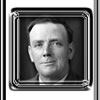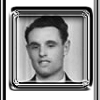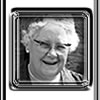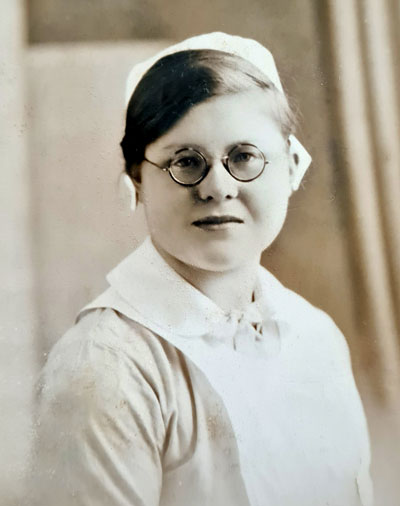|
 |
1930's More information on nursing when Norah would have been employed.
The aftermath of the 1914–1918 war had left European economies dependent on American investment, and now the US banks were forced to call in their assets from overseas. The effects on Britain were devastating, and by 1932 unemployment peaked at 2,745,000. This was almost 10 per cent of the working-age population. Ominously, the worst affected country was Germany, where hyperinflation led to workers being paid in wheelbarrows of worthless banknotes and prices rose three times a day. Mass unemployment at home continued throughout much of the 1930s, hitting the industrial north and South Wales particularly hard. At the time unemployment benefit lasted for 26 weeks, after which people were subjected to the hated Household Means Test to receive money that was barely enough to survive on. Long-term unemployment meant thousands of families relied on this for years. An editorial in Nursing Times voiced nurses' dismay at their inability to offer any real help to the unemployed: 'As a profession whose raison d'etre is the relief of pain, we feel all the more our impotence in this particular instance; there is so little we can do individually, much as we ache to help.' A series of hunger marches took place, culminating in the Jarrow march of 1936. Two hundred men marched the 300 miles to London from the north-eastern town of Jarrow, where there was 70% unemployment. They aimed to petition the government for assistance in creating jobs and to demonstrate to people in the south that they were respectable citizens who could not be blamed for their situation. Ellen Wilkinson, the local MP, accompanied the marchers, and pleaded with the delegates at the Labour Party conference to 'tell the government our people shall not starve'. However, despite widespread public sympathy the marchers received no assistance. Unemployment declined slowly after 1935, but it was not until Britain began rearming in preparation for the Second World War that industry prospered and the worst effects of the depression were over. A report on food, health and income in 1936 by John Boyd Orr revealed that about half the population could not afford suitable food for growth and health. The economic climate meant that, as in the 1920s, there was little money for health and welfare reform. In fact a parliamentary committee on national expenditure in 1931 recommended radical cuts in government spending on public services and unemployment benefits. However, the appetite for reform was still there, and a growing acknowledgement that the state should play its part in the health of the nation. A report on the political and economic planning of the health services in 1937 emphasised the importance of nutrition, housing, economic and social security on health. It recommended that health care be publicly funded and administered through regional authorities, and called for more research into the causes of ill health and means of prevention. Nursing continued to focus on professional standards, but now attention turned to the quality of prospective probationers (nursing students). There was some disappointment that the profession was failing to attract enough candidates who had remained in education until the age of 18, and in 1932 the GNC announced that from 1936 no candidate should be allowed to enter the preliminary state examination without having either a General School Certificate or equivalent or passing a general knowledge examination set by the college. Before it could become selective however, the profession had to attract the candidates to be selective about – Britain had a nursing shortage. One cause of its recruitment problems was the fact that the jobs open to women were not hit by unemployment as badly as heavy industry. Women were attractive to employers because they earned lower wages for the same work. This meant that those in the labour market often had a number of options – many of which were more attractive than nursing. A report from the influential Lancet Commission on Nursing in 1932 pointed out one of the factors deterring many women from choosing a nursing career. While probationers were given high levels of responsibility and required to work long hours on the wards, the nurses' homes they were expected to live in were repressive institutions. Probationers had little opportunity for fun. The report concluded that trained nurses should be given substantial pay rises, while probationers should have their hours reviewed, be given good training and have reasonable freedom and privacy. All nurses should also be relieved of domestic duties not directly related to nursing care. Although the Lancet Commission had supported nurses in improving working and living conditions it did not endorse the profession's higher education ambitions. Universities in Leeds and London now offered diploma courses to trained nurses, but the commission did not consider it appropriate to link preregistration training to academic institutions. Instead it suggested that schoolgirls who wanted to become nurses be allowed to study for part of the state examination before leaving school. The profession did not see the commission's suggestion as a practical option. The College of Nursing believed many suitable girls would be lost because they had not chosen nursing as a career early enough. The nursing shortage was still an issue in 1939, when the Interdepartmental Committee on Nursing made similar recommendations to the Lancet Commission seven years earlier. In addition to increased pay, reduced hours and improved living conditions, the committee called for nurse training to be funded by the state, nurses' pay to be set nationally and the development of an assistant nurse role. Towards the end of the decade nurses, like the rest of the nation, faced far greater challenges than its campaigns for better pay or acceptance into higher education. When the war began Nurses were asked to volunteer for national service almost as soon as it was declared. So many responded that the Civil Nursing Reserve could barely cope with the flood of applications. Less than a year later the profession was feeling less enthusiastic, due to what it saw as unfair treatment. Along with many of its members the Royal College of Nursing – as it had been since 1939 – protested about the fact that nurses in the Civil Defence Service had not been given a pay rise even though nursing auxiliaries and male orderlies had. Key events during the 1930s 1932
|
|









